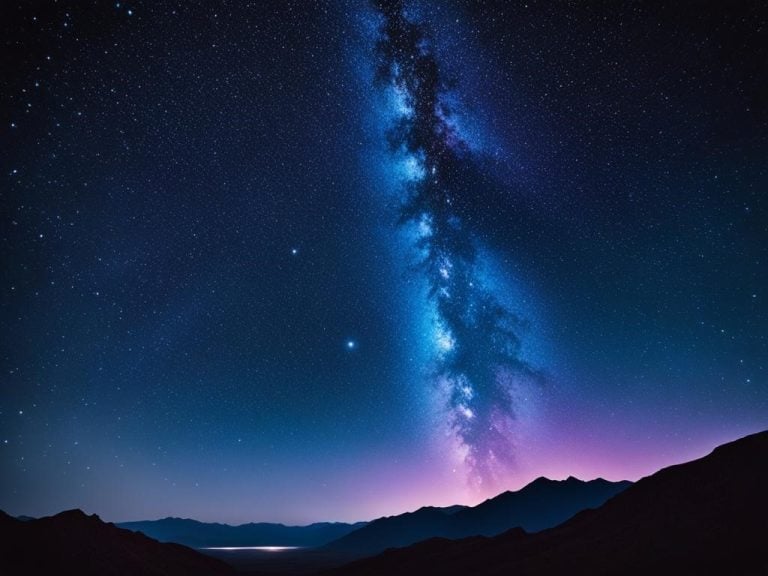Explore the Wonders of the Indus Constellation
Modified: July 29, 2024 Author: International Star Registry
Did you know we have found 88 constellations that cover the whole sky?
The Indus constellation is not so well-known but is still amazing. Petrus Plancius, a Dutch astronomer, first named it in the late 16th century. Indus is in the far southern sky and is named for the people of the East Indies. People from the East Indies, South Africa, Australia and South America would have seen Indus’s stars ages before European astronomers.
Indus has many important stars, like Alpha Indi, which is the brightest. The star patterns here slowly change because of the Milky Way’s stars moving.

Key Takeaways:
- The Indus constellation is one of the 88 recognized modern constellations.
- It was named by Petrus Plancius in the late 14th century.
- Several notable stars, including Alpha Indi, can be found in the Indus constellation.
- The star patterns of constellations change slowly over time due to the motion of stars within the Milky Way.
- Indigenous cultures in Australia and South America likely observed the stars of Indus before European astronomers.
Want to know more about constellations? Check out Universe Today, The Planets, and James Webb Discovery.
The History and Mythology of the Indus Constellation
The Indus constellation is a faint area in the southern circumpolar region. Although it would have been observed by people in the southern hemisphere before being named by Petrus Plancius in the late 14th century, stories and history of the constellation are difficult to find.
The name is thought to be derived from the people of the East Indies, from India, or from the Native Americans.
People from different places named the stars and constellations as they mapped the sky. They each had their own stories. In the 16th century, a Dutch expert, Petrus Plancius, made the Indus constellation famous.
He said it symbolized the indigenous people of the Indian Ocean. This broad range of cultural possibilities shows how the Indian subcontinent’s history and culture are vast and rich. The Indus constellation tells a story of diversity and wonder in our universe.
The Cultural Significance of the Indus Constellation
Stars and constellations are key in shaping cultures worldwide. In India, they are tied to spiritual beliefs. They have deep meanings and are part of stories about the universe’s energies.
The Indus group of stars isn’t widely discussed in old Indian writings. Yet, it reminds us of the deep link between space and people. It highlights the beauty and variety of India, its lands, and cultures.
Learning about the Indus constellation shows us how the sky and stories from long ago connect. This knowledge deepens our love for the universe’s marvels.
Significance of Naming a Star in the Indus Constellation
Naming a star in the Indus constellation is a unique way to mark special moments. It suits occasions like birthdays, Christmas, and anniversaries. The process to name a star through International Star Registry is simple and open to all.
By naming a star, you are giving a one-of-a-kind present that gives children and adults a special connection to the universe. Your star will be recorded in the unique International Star Registry star catalog along with others preserved for centuries.
Each named star comes with a fancy certificate. This certificate shows the star’s position in the Indus constellation. You also get a star chart to help you find your star in the sky.
Naming a star in the Indus constellation shows your love, honors memories, or expresses gratitude. It’s a meaningful gift that reflects the never-ending connection between people.
Exploring the Stars of Indus
The Indus constellation has many stars. Each one adds to the beauty and stories in the sky. The stars Alpha Indi and Beta Indi are very important.
Alpha Indi, known as the “Persian,” is the brightest in Indus. This Orange Giant has a magnitude of 3.1 and its light shines for all to see, making the sky more lovely. Beta Indi is also special. It’s also an Orange Giant with a magnitude of 3.7. Together, these stars and more make amazing shapes. These shapes have amazed people who study the sky for a long time.

Indus is special, even though not everyone knows it. Its patterns of stars, like Alpha Indi and Beta Indi, are quite something. They make you want to look closer at the night. As you stare, you’ll see the secrets of Indus. It will take you on a magical trip through space.
Do you love looking at stars? The Indus constellation is great for any star fan. It has stars waiting for you to find them, like Alpha Indi and Beta Indi. They make your star watching time really special.
Naming a Star in the Indus Constellation Through International Star Registry
If you’re looking for a unique and meaningful gift, consider the Indus constellation. With International Star Registry, you can buy a star in this beautiful area. Your special someone will love this gift forever.
The Indus constellation is the 49th largest, enchanting those who see it. This makes it stand out in the night sky.
It is only seen by people in the south, sitting between latitudes +15° and -90°. Even though it’s not very bright, its unique beauty is waiting to be discovered.
The Alpha Star and Beta Star of Indus are both Orange Giants. Together with the Delta Star, a White Star, they form the shape of a right triangle. There are 3 galaxies in Indus and in 2015 a super luminous supernova called ASASSN-15lh was observed.
Naming a star through International Star Registry in the Indus constellation is easy. You can do it on their website. Pick a star gift, choose any constellation and star package, and give the most memorable gift in the universe. It’s perfect for any celebration or to remember a loved one.
You get a certificate and a star map when you name a star. They’re beautifully made. These make great gifts, showing the star with its new, personal name.
Don’t miss out on this amazing chance. Visit International Star Registry’s website. See the magic of naming a star in the Indus constellation.
The Allure of the Indus Constellation in the Night Sky
The Indus Constellation might not be the first on your star list. But, its long history and interesting stories make it great for exploring. Found in the Southern Hemisphere, it shows a special view of the sky.
In the Southern Hemisphere’s night sky, the Indus Constellation shines. It has a unique pattern featuring three perfectly placed stars, adding beauty to the sky. This pattern is fascinating to look at and brings a feeling of mystery.
The Indus Constellation is like a quiet friend, inviting you to South Hemisphere’s sky wonders. Its beauty will surely catch your eye as you observe the night.
The Significance of the Indus Constellation
The Indus Constellation is a big part of starry history. In addition to the theory that it is named for the people native to the areas of the Indian Ocean, some also speculate that it’s named after the famous Indus River in South Asia. This links the stars to a region with a rich past and culture.
People have always been interested in the Indus Constellation. It’s not just pretty but it also has a mysterious origin story. Exploring its myths reveals tales that have lasted for ages.
Love looking at the night sky or just enjoy its beauty? The Constellation Indus is waiting to amaze you. Spend some time learning about it. Let its charm take you on a journey to discover the unknown.
How to Name a Star in the Indus Constellation
If you dream of naming a star in the Indus constellation, International Star Registry can help. Just click here to start. This is a special and unique experience to give a memorable gift.
The Indus is a constellation with a mysterious story and meaning. Dutch astronomer Petrus Plancius named it in the late 16th century. Stars in the Indus have names like Alpha Indi (the “Indian” or the “Persian”). This is the brightest star. And Beta Indi is sometimes known as the “Southern Indian.” It is very important in this constellation.
Naming a star in the Indus is simple. Just pick the Indus option on their website. You can name it whatever you like. You might name it after a loved one, for a special time, or just because. After you name it, you get a certificate and a star map. This is a lovely way to remember your star in the Indus.

International Star Registry is a trusted place to name stars. It’s a great gift for any occasion. Naming a star in the Indus is a memorable experience. Start by visiting their site to make a mark in the sky.
For more on the Indus and its story, check Wikipedia or Constellation-Guide.com.
Celebrities and Named Stars in the Indus Constellation
Ever wondered how stars and celebrities could be linked? In the Indus Constellation, this link shines bright. A great example is the famous actor Ben Foster. He has his star in this amazing starry land.
At International Star Registry, you can make this connection last forever. You can name a star after someone you love. It’s a unique gift that leaves a lasting memory.
When you name a star in the Indus Constellation, you honor someone special. It’s a unique way to show love and appreciation. This is perfect for birthdays, anniversaries, or any special day.
Naming a star creates a beautiful connection between the person and the starry sky. It’s a heartfelt way to show the deep and eternal bond people share with the universe.
Would you like to learn more about the Indus Constellation and the night sky? Explore this link for a detailed guide. For stories about the Indus Constellation, visit the Wikipedia page.
Interested in star names and what they mean? This resource has all the info you need.
Why not be like a celebrity and name a star in the Indus Constellation? Discover a piece of the universe that’s truly yours. It’s the perfect celestial gift for someone special.
Buy a Star in the Indus Constellation
Ready to make someone’s day special? You can buy a star in the Indus constellation. It’s a gift for a lifetime. Visit starregistry.com to see your choices and buy one today.
Buying a star in the Indus is a unique and lasting gift. It is perfect for marking important moments, honoring loved ones, or celebrating. The Indus constellation has a deep history and lots of stories, adding magic to this gift.
Just think of the happiness when they get a star certificate. It shows the details of their star in the Indus. Their star name will be recorded forever, giving them a special connection to the universe.
So why not buy a star now? It’s a one-of-a-kind gift for your loved one. The memory will keep shining for years.
Conclusion
The Indus Constellation is a cosmic wonder that amazes people visiting the southern hemisphere. It comes with a mysterious history, stories, and meanings. This makes it perfect constellation to choose for anyone who loves the night sky. To find a unique gift or mark a big event, naming a star here is just right.
International Star Registry pioneered the concept of naming stars in 1979. It lets you name a star, creating a connection with the universe’s beauty. No matter the event, this personalized gift will always be loved.
Feel the pull of the Indus Constellation. Take a journey with the stars, discovering the beauty of the universe. Head to International Star Registry now and name a star in the Indus Constellation. This will be an experience you’ll never forget.
FAQ
What is the Indus Constellation?
The Indus Constellation is a group of stars in the sky that not many people know. A Dutch astronomer named Petrus Plancius named it in the late 16th century. It’s now known by the International Astronomical Union (IAU).
Does the Indus Constellation have any cultural significance?
The Indus Constellation isn’t directly related to ancient Indian myths. But, stars and constellations are very important in Indian culture. The old texts from Hinduism and Jainism say that stars are like gods.
How can I commemorate a special occasion by naming a star in the Indus Constellation?
To buy a star in the Indus Constellation, go to International Star Registry. They have an easy way to select a star package, choose a star star named and constellation, and they’ll send you special certificates and star maps.
Which stars are notable in the Indus Constellation?
Alpha Indi (called “the Indian”) and Beta Indi (“the Southern Indian”) are important stars in Indus. They, together with Delta Indi, make a bright triangle that is the Indus Constellation.
What is the allure of the Indus Constellation in the night sky?
The Indus Constellation is unique and beautiful in the night sky. The most famous event in Indus is a supernova of 2015. Also, its pattern in the sky is quite special, especially in the Southern Hemisphere.
How can I buy a star in the Indus Constellation?
To buy a star in Indus, head to starregistry.com. They have many options for different budgets. Buying a star is a special and unforgettable gift.
Source Links
- Explore the Night Sky: A Beginner’s Guide to the 88 Constellations – https://astrotelescopium.com/blogs/news/unlocking-the-mysteries-of-the-night-sky-a-beginners-guide-to-the-88-constellations
- Indus | Indus Valley Civilization, Harappan, Mohenjo-Daro – https://www.britannica.com/place/Indus
